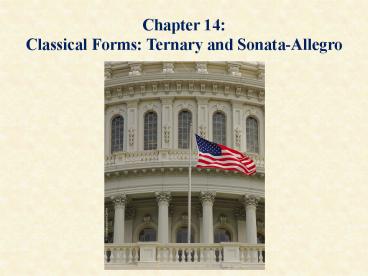Chapter 14: Classical Forms: Ternary and Sonata-Allegro - PowerPoint PPT Presentation
Title:
Chapter 14: Classical Forms: Ternary and Sonata-Allegro
Description:
Chapter 14: Classical Forms: Ternary and Sonata-Allegro Ternary Form (ABA) Statement Contrast Repetition Twinkle, Twinkle, Little Star Minuet and Trio ... – PowerPoint PPT presentation
Number of Views:146
Avg rating:3.0/5.0
Title: Chapter 14: Classical Forms: Ternary and Sonata-Allegro
1
Chapter 14 Classical Forms Ternary and
Sonata-Allegro
2
Ternary Form (ABA)
- Statement Contrast Repetition
- Twinkle, Twinkle, Little Star
3
Minuet and Trio in Ternary Form
- Minuet Stately dance in triple meter
- Originally a popular dance in the Baroque Era
- Became Listening Music in the Classical Era
- Trio serves as a contrasting (B) section
- Originally only played by three instruments
4
Eine kleine Nachtmusik by Mozart (1787)
- Serenade a light, multimovement piece for
strings or small orchestra - Movement III Minuetto (pg. 167)
5
Sonata-Allegro Form
- Four Movement Form
Movement 1 2 3 4
Form Sonata-allegro ABA, Theme and Variations, or Rondo Minuet in Trio (ABA) Sonata-allegro, Theme and Variations, or Rondo
Mood Serious and substantive despite fast tempo Lyrical and tender Usually light and elegant, sometimes spirited Bright, lighthearted, sometimes humorous
Tempo Fast Slow Lively Fast
6
The Shape of Sonata-Allegro Form
- Drama and conflict within a single movement
- Three major sections
- Exposition Presents thematic material
- Opposition and blending of contrasting themes
- Development Thematic material from exposition is
developed - Recapitulation Themes return in original order
7
Hearing Sonata-Allegro Form
- Keep the sonata-allegro diagram in mind
- Listen for the four distinctive musical styles in
sonata-allegro form - Thematic sections States the melodies
- Transition Moves the music forward
- Development Expands musical ideas
- Concluding passages Provides closure
- Eine kleine Nachtmusik, movement I Allegro
(p.172) - First theme aggressive, fanfare-like opening
- Second theme quieter, lighter
- Closing theme cheerful
8
Overture to Don Giovanni by Mozart
- Sonata-allegro form
- P. 174































